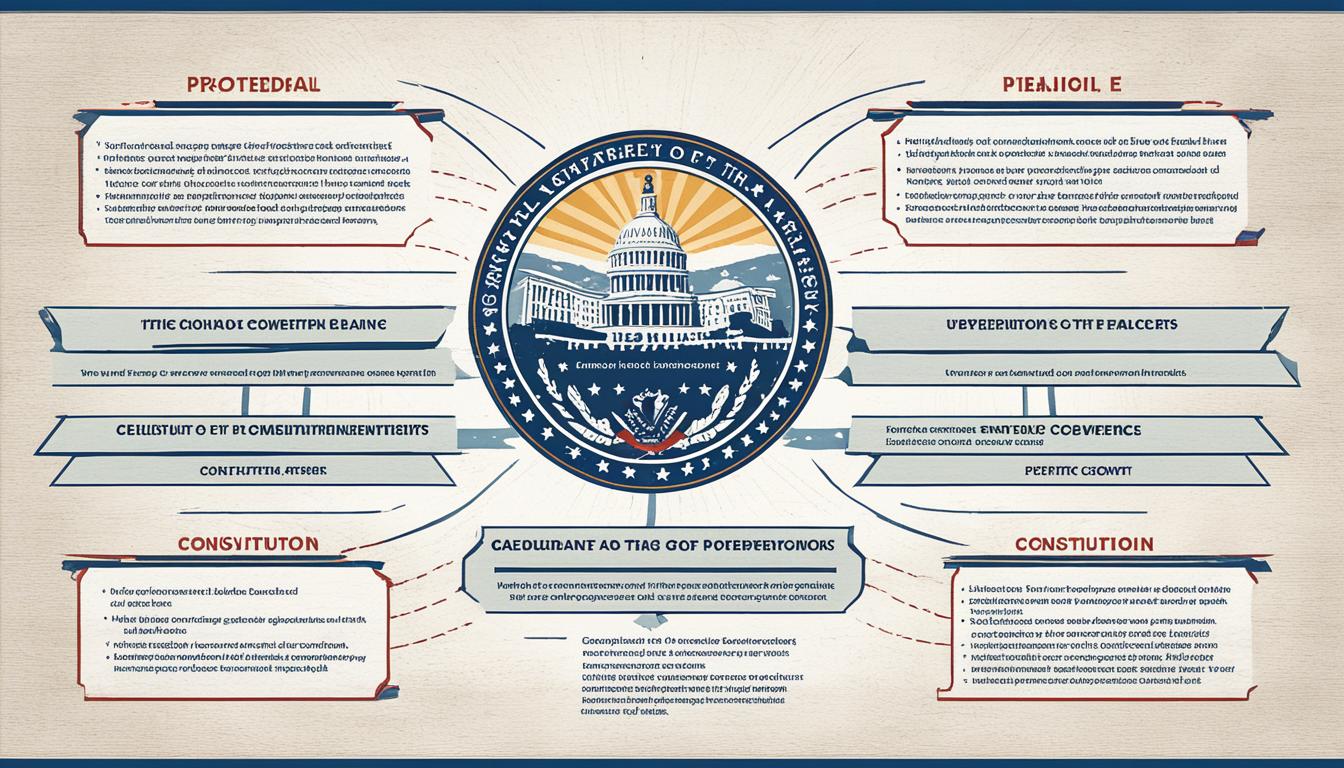In the fabric of American democracy, the Constitution has been woven as an essential safeguard against the tendrils of tyranny. Its role is not a mere historical artifact but a living blueprint that actively shapes the governance of the United States. The Constitution meticulously outlines a series of safeguard mechanisms to thwart the rise of despotism and affirm a commitment to freedom. It embodies a profound understanding that power must be dispersed and checked to prevent its concentration in the hands of a few. Hence, the role of the Constitution is as critical today in preventing tyranny as it has ever been, serving as the backbone of a country perennially striving to fulfill its democratic promise.
Key Takeaways
- The Constitution is pivotal in preventing the concentration of power and guarding against tyranny.
- Separation of powers and checks and balances are key mechanisms enshrined in the Constitution to protect American democracy.
- It ensures that no single branch of government becomes omnipotent, preserving the nation’s liberties.
- Federalism underpins the relationship between national and state governance, distributing authority to prevent despotism.
- The enduring role of the Constitution upholds democratic principles, remaining relevant in modern governance.
Historical Context and the Establishment of the U.S. Constitution
Steeped in the historical context of post-revolutionary America, the establishment of the U.S. Constitution was a pivotal moment aimed at crafting a guard against tyranny. Faced with the weaknesses of the Articles of Confederation, the fledgling nation’s leaders congregated during a sweltering summer in 1787 to devise a plan that would ensure a robust framework for governance and the preservation of liberty. The absence of centralized governance raised concerns over the new nation’s ability to thrive and necessitated a new structure that would stand the test of time.
The Summer of 1787: Crafting a Guard Against Tyranny
In the summer of 1787, the Founding Fathers convened in Philadelphia, keenly aware of the perils of oppressive rule. They embarked on the onerous task of constructing a document that would both empower and limit a centralized authority. Their debates focused on creating a balanced government infused with checks and balances, aimed to protect citizens and states alike from the iron grip of tyranny.
The Weaknesses of the Articles of Confederation
The precursor to the Constitution, the Articles of Confederation, manifested critical deficiencies. It lacked the ability to effectively levy and collect taxes, regulate interstate commerce, and enforce laws. The federal government’s impotence under the Articles sowed seeds of economic and diplomatic discord, making evident the need for substantial reform.
Inter-state Relations and the Absence of Centralized Governance
An undercurrent of mutual distrust among states and the inability to present a unified front against international challenges marked the shortcomings of inter-state relations. The lack of a strong executive added to the chaos, leaving the nascent republic fragmented. This turbulent landscape emphasized the urgency for establishing a central governing body, endowed with the necessary authority to manage collective matters but with precise boundaries to safeguard against authoritarian rule.
As we reflect on the historic Philadelphia Convention, it becomes clear that the enduring legacy of the U.S. Constitution is rooted in its origins. Formed from the necessity to mend the weaknesses of a loose confederation and unify a disjointed collection of states, the Constitution emerged as both a product and protector of its time. Today, it continues to serve as the bulwark of American governance, epitomizing the enduring principles of federalism and democracy born out of a crucial historical context.
How Does the Constitution Guard Against Tyranny
The United States Constitution is a testament to the foresight of the nation’s founders in guarding against tyranny. By weaving together a robust system of Constitutional protections, it remains the bedrock of American freedom and governance. Within its framework, the separation of powers is markedly evident, establishing distinct functions for the legislative, executive, and judicial branches. This deliberate distribution of power serves as a bulwark against the overreach of any single branch.
In addition, the architecture of governance includes a finely tuned system of checks and balances. Each branch is invested with the authority to scrutinize and limit the functions of the others, fostering a climate of transparency and mutual oversight. This reciprocal accountability is critical in curbing excesses and defending the liberty of citizens.
The principle of federalism further decentralizes power by reserving certain rights and responsibilities to state governments. This dispersion counteracts the dangers of a too-powerful central government, encouraging a more locally attuned and responsive political ecosystem. The table below outlines the key features and functions of these foundational principles:
| Principle | Function | Impact on Tyranny |
|---|---|---|
| Separation of Powers | Divides governmental power into three distinct branches. | Prevents any one branch from gaining unchecked power. |
| Checks and Balances | Grants each branch oversight over the others. | Enables branches to restrain others and enforce accountability. |
| Federalism | Distributes powers between the national and state governments. | Protects against centralized government overreach. |
Together, these mechanisms operate in concert to fortify the nation against the rise of tyranny. It’s a dynamic, living system designed to evolve and adapt, ensuring that the flame of liberty continues to burn bright for generations to come.

The Lasting Impact and Modern Significance of Constitutional Protections
The fabric of American democracy is fundamentally woven with the resilient threads of Constitutional protections, which have borne the test of time, continuing to have profound relevance and a lasting impact on modern governance. These enduring principles act as the bulwark against the concentration of power, ensuring a government by the people and for the people remains more than an idealistic notion. The foresight exemplified by the nation’s Founding Fathers in embedding mechanisms such as the separation of powers, checks and balances, and federalism into the Constitution has created a legacy that transcends generations, fostering a society vigilant in safeguarding liberties.
In a contemporary context, these Constitutional safeguards are not mere historical artifacts but are pivotal in navigating the complex political and social challenges facing the United States today. From civil rights disputes to executive overreach, the structural design provided by the Constitution ensures that power remains checked, and freedoms preserved. The modern significance of such protections is undeniably evident as they continue to influence judicial interpretations, legislative processes, and executive functions, establishing an accountable governance framework committed to the tenets of American democracy.
It is essential to acknowledge how the Constitution’s protections operate effectively in an era vastly different from their inception. The notable adaptability of these provisions is a testament to their robust nature, designed to evolve with the nation’s growth while steadfast in safeguarding individual liberty and justice. In reflection, the lasting impact of the United States Constitution reaffirms its essential role in not only preventing tyranny but in perpetuating the spirit of democracy that defines the American experience, inspiring and guiding the nation towards a future steadfast in these enduring principles.
FAQ
What role does the Constitution play in preventing tyranny?
How was the U.S. Constitution established?
What were the weaknesses of the Articles of Confederation?
How does the Constitution guard against tyranny?
What is the lasting impact and modern significance of Constitutional protections?
Source Links
- https://www.sesd.org/site/handlers/filedownload.ashx?moduleinstanceid=8589&dataid=5862&FileName=Constitution Essay2.pdf
- https://libertyembers.com/how-constitution-guards-against-tyranny/
- https://constitutingamerica.org/90day-aer-the-united-states-constitution-as-a-bulwark-against-tyranny-guest-essayist-jeanne-mckinney/





